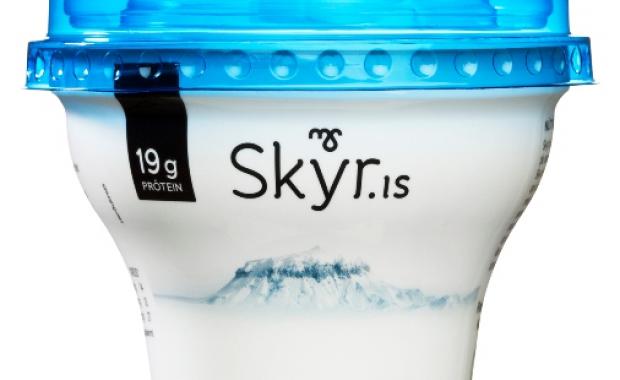Skyr is a traditional Icelandic dairy product and, while resembling yogurt, it is, correctly speaking, a cheese. The product is made from skim milk after the cream has been removed. The milk is then warmed with live cultures from previous batches of skyr and strained from the whey after it has thickened.
Skyr-making dates all the way back to the 9th century. Traditionally skyr was served with cream and brown sugar, but nowadays it’s increasingly used as a key ingredient for cheese cakes, crème brulée (called skyr brulée), and smoothies.

Gunnar Karl Gíslason, head chef and owner of Dill Restaurant and author of the cookbook North: The New Nordic Cuisine of Iceland, is known to be a rather unorthodox chef. His style of cooking started out as “new Nordic” cuisine but has evolved into more traditional Icelandic cuisine.
“We use skyr a great deal at Dill Restaurant. Skyr is most commonly used in desserts or cold sauces, but recently we’ve begun to experiment with adding skyr to warm dishes too,” Gunnar Karl explains.
When making skyr at home, milk is warmed with live cultures from previous batches, a method similar to that of making sourdough bread. It’s easy enough; you only have to mix milk with a dollop of store-bought skyr with live cultures and heat it up. For those who cannot buy skyr at their local supermarket, Gunnar Karl recommends using an age-old method.
“Back in the old days, people would pour skimmed milk into a container and leave it outside until the bacteria needed to make the skyr had begun to form. Some people would even experiment by leaving the milk in different places; down by the seashore, in little hollows, or high up on heaths, to see which produced the best bacteria. One could easily do the same today—that would be real skyr-making.”
Asked whether there is a big difference in taste between store-bought skyr and homemade skyr, Gunnar Karl says the two are hardly comparable. “It depends on the brand of store-bought skyr, but many brands are hardly skyr anymore. The recipe has been altered so much and the product is chock full of sugar and artificial flavours.”
The recipe:
You’ll need: 1 litre skimmed milk and a tablespoon of regular skyr (preferably organic).
1 First make the skyr. In a non-stick saucepan, heat the milk over a low heat to 95C/200F and maintain this temperature for 10 minutes. It’s crucial to keep the temperature steady, if it fluctuates too much then the skyr will either scorch or not set properly. Stir the milk throughout this process to prevent it from sticking to the bottom of the pan. Remove the saucepan from the heat and set aside at room temperature. Let it cool to 39C/102F. It takes over an hour to heat the milk and almost 30 minutes for it to cool to room temperature.
Whisk the tablespoonful into the milk once it has cooled to room temperature.
2 Cover with a kitchen towel and let the milk stand at room temperature for 12-15 hours (or at most 24 hours), until it has thickened to the consistency of Greek yoghurt and the curds have separated from the whey.
3 At this point, you can either stir the whey into the skyr to thin it, or drain it through cheesecloth for a thicker consistency. Cover tightly and refrigerate until chilled. The skyr, either thinned with the whey or strained, will keep in the fridge for up to 1 week. The whey will keep for the same length of time in an airtight container – delicious in baked goods!
Enjoy!
Skyr’s popularity is on the rise—locally and internationally. Chef Gunnar Karl Gíslason, author of the cookbook North: The New Nordic Cuisine of Iceland, was kind enough to teach us how to make thick, rich, delicious homemade skyr.
Skyr is a traditional Icelandic dairy product and, while resembling yogurt, it is, correctly speaking, a cheese. The product is made from skim milk after the cream has been removed. The milk is then warmed with live cultures from previous batches of skyr and strained from the whey after it has thickened.
Skyr-making dates all the way back to the 9th century. Traditionally skyr was served with cream and brown sugar, but nowadays it’s increasingly used as a key ingredient for cheese cakes, crème brulée (called skyr brulée), and smoothies.

Gunnar Karl Gíslason, head chef and owner of Dill Restaurant and author of the cookbook North: The New Nordic Cuisine of Iceland, is known to be a rather unorthodox chef. His style of cooking started out as “new Nordic” cuisine but has evolved into more traditional Icelandic cuisine.
“We use skyr a great deal at Dill Restaurant. Skyr is most commonly used in desserts or cold sauces, but recently we’ve begun to experiment with adding skyr to warm dishes too,” Gunnar Karl explains.
When making skyr at home, milk is warmed with live cultures from previous batches, a method similar to that of making sourdough bread. It’s easy enough; you only have to mix milk with a dollop of store-bought skyr with live cultures and heat it up. For those who cannot buy skyr at their local supermarket, Gunnar Karl recommends using an age-old method.
“Back in the old days, people would pour skimmed milk into a container and leave it outside until the bacteria needed to make the skyr had begun to form. Some people would even experiment by leaving the milk in different places; down by the seashore, in little hollows, or high up on heaths, to see which produced the best bacteria. One could easily do the same today—that would be real skyr-making.”
Asked whether there is a big difference in taste between store-bought skyr and homemade skyr, Gunnar Karl says the two are hardly comparable. “It depends on the brand of store-bought skyr, but many brands are hardly skyr anymore. The recipe has been altered so much and the product is chock full of sugar and artificial flavours.”
The recipe:
You’ll need: 1 litre skimmed milk and a tablespoon of regular skyr (preferably organic).
1 First make the skyr. In a non-stick saucepan, heat the milk over a low heat to 95C/200F and maintain this temperature for 10 minutes. It’s crucial to keep the temperature steady, if it fluctuates too much then the skyr will either scorch or not set properly. Stir the milk throughout this process to prevent it from sticking to the bottom of the pan. Remove the saucepan from the heat and set aside at room temperature. Let it cool to 39C/102F. It takes over an hour to heat the milk and almost 30 minutes for it to cool to room temperature.
Whisk the tablespoonful into the milk once it has cooled to room temperature.
2 Cover with a kitchen towel and let the milk stand at room temperature for 12-15 hours (or at most 24 hours), until it has thickened to the consistency of Greek yoghurt and the curds have separated from the whey.
3 At this point, you can either stir the whey into the skyr to thin it, or drain it through cheesecloth for a thicker consistency. Cover tightly and refrigerate until chilled. The skyr, either thinned with the whey or strained, will keep in the fridge for up to 1 week. The whey will keep for the same length of time in an airtight container – delicious in baked goods!
Enjoy!





